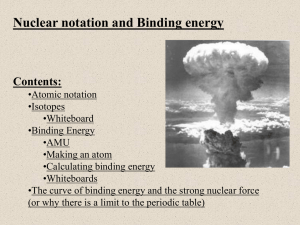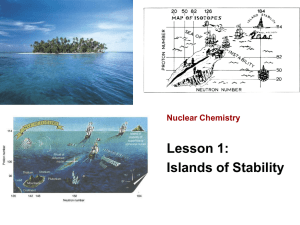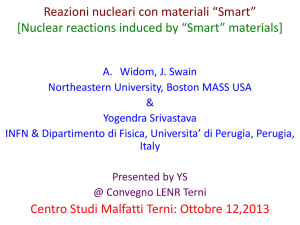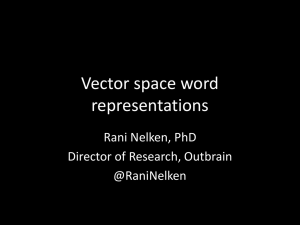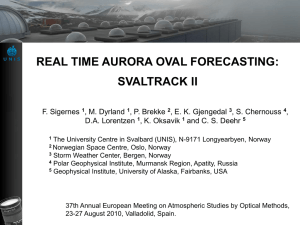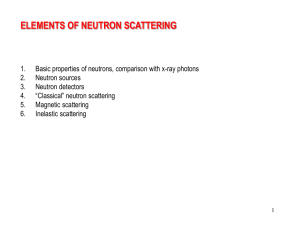Neutron Interactions with Matter: A Physics Overview
advertisement
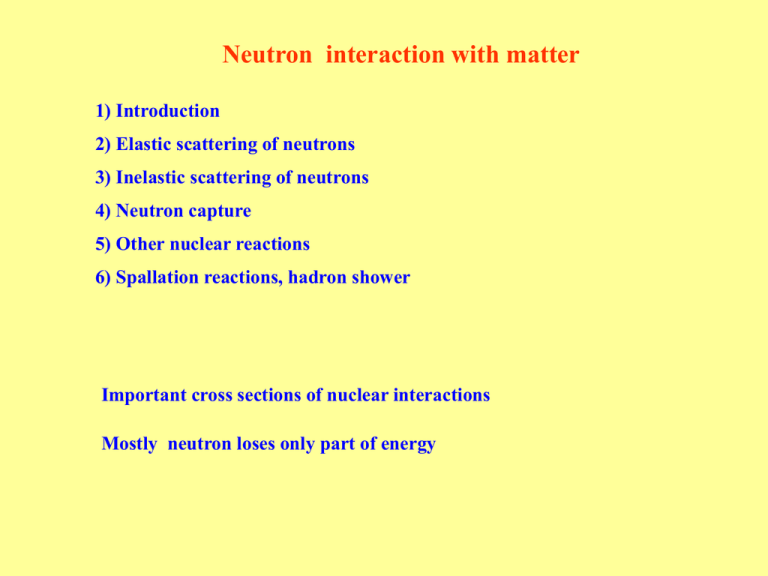
Neutron interaction with matter 1) Introduction 2) Elastic scattering of neutrons 3) Inelastic scattering of neutrons 4) Neutron capture 5) Other nuclear reactions 6) Spallation reactions, hadron shower Important cross sections of nuclear interactions Mostly neutron loses only part of energy Introduction Neutron has not electric charge → interaction only by strong nuclear interaction Magnetic moment of neutron → interaction by electromagnetic interaction, mostly negligible influence Different energy ranges of neutrons: Ultracold: E < 10-6 eV Cold and very cold: E = (10-6 eV – 0,0005 eV) Thermal neutrons – (0,002 eV – 0,5 eV) neutrons are in thermal equilibrium with neighborhood, Maxwell distribution of velocities, for 20oC is the most probable velocity v = 2200 m/s → E = 0,0253 eV dN 4N v dv v e 2 v 3 0 π v v0 2 σ(v) σ 0 0 v Epithermál neutrons and resonance neutrons: E = (0,005 eV – 1000 eV) Cadmium threshold: ~ 0,5 eV - with higher energy pass through 1 mm of Cd Slow neutrons: E < 0,3 eV Fast neutrons: E = (0,3 eV – 20 MeV) Neutrons with high energies: E = (20 MeV – 100 MeV) Relativistic neutrons: 0,1 – 10 GeV Ultrarelativistic neutrons: E > 10 GeV Elastic scattering of neutrons Most frequent process used for kinetic energy decreasing (moderation) of neutrons Moderation – process of set of independent elastic collisions of neutron on nuclei Usage of nucleus reflected during scattering for neutron energy determination Maximal transferred energy (nonrelativistic case of head-head collision): MCL: pn0 = pA - pn ECL: En0KIN = EAKIN + EnKIN pn02/2mn = pA2/2mA + pn2/2mn MCL: pn2 = pA2 – 2pApn0 + pn02 mApn2 = ECL: mApn2 = - mnpA2 mApA2 – 2mApApn0 + mApn02 + mApn02 We subtract equation: 0 = mApA2 + mnpA2 – 2mApApn0 mApA + mnpA = 2mApn0 The heavier nucleus the lower energy can neutron transferred to it: pA 2m A pn0 m A mn EA 4m Amn En0 m A m n 2 4 A En0 A 1 2 Nucleon number A Usage of hydrogen (θ – neutron scattering angle, ψ – proton reflection angle) mp = mn: pn = pn0·cosθ En = En0·cos2θ pn = pn0·sinψ En = En0 ·sin2ψ For nucleus: EA 4 A E n0 A 1 2 ψ = π/2-θ cos CM 1 2 cos 2 cos 2 EA pp = pn0·sinθ Ep = En0·sin2θ pp = pn0·cosψ Ep = En0·cos2ψ 2 A En0 A 1 2 1 cos CM Reflection angle φ Elastic scattering: in our case particle 1 – neutron particle 2 – proton, generally nucleus Dependency of energy transferred to proton on reflected angle Small expose with derivation of relation between laboratory and centre of mass angles: Laboratory coordinate system Centre of mass coordinate system Derivation of relation between scattering angles at centre of mass and laboratory coordinate systems: Relation between velocity components to the direction of beam particle motion is: ~ v 1 cos v CM ~ v 1 cos ~ v 1 cos ~ v 1 cos v CM Relation between velocity components to the direction perpendicular to beam particle motion: ~ ~v sin ~ sin 1 tan ~ ~v cos ~ v cos v CM ~v 1 1 CM Ratio of these relations leads to: For elastic scattering is valid: v m ~CM 1 v 1 m2 ~ cos cos ~ 2 1 2 (1 2 cos ) Equation can be rewrite to: m1 m2 mn mp 1 derive! cos ~ 1 2 and then cos 2 and required relation is valid: ~ (1 2 cos 1) 1 2 cos ~ 1 cos ~ 2 cos 2 1 ~ 2 2 2 2 cos 2 cos 1 2 sin 1 2 (1 cos ) 1 1 2 cos ~ v 1 sin ~ v 1 sin Angular distribution of scattering neutrons at centre of mass coordinate system: P ( CM ) d CM 2 sin CM S CM S d CM Relation between angular distribution and energy distribution: We introduce and express distribution of transferred energy: P ( CM ) d CM P E A dE A P E A 2 sin CM CM d CM S dE A We determine appropriate differential dEA: EA 2 A E n0 A 1 2 1 cos CM dE A 2 A E n0 A 12 sin CM d CM Introduce for dEA: (1 A ) S ( CM ) 2 P(E A ) S A E n0 σS(θCM) = σS/(4π) σS(θCM) - isotropy (it is valid approximately for protons up to En0 < 10 MeV) (1 A ) S ( CM ) 2 P(E A ) A Efficiency ε is given: S E n0 1 (1 A ) 4 1 e A 2 1 E n0 N j S d Energy distribution of reflected protons for En0 < 10 MeV Coherent scattering – diffraction on lattice Magnitude of energy neither momentum and wave length of neutrons are not changed Diffraction of neutrons on crystal lattice is used n·λ = 2d·sin Θ Mentioning: Bragg law: λ En << mnc2 hc 2m n c E n E 2 2 n hc λ 2m n c 1 2 En = 0,0288 eV½∙nm for En in [eV] Lattice constants are in the order 0,1 – 1 nm → Neutron energy in the orders of meV up to eV E [eV] 0,001 0,005 0,01 0,1 1 10 100 1000 λ [nm] 0,91 0,41 0,29 0,091 0,029 0,0091 0,0029 0,00091 Inelastic neutron scattering Competitive process to elastic scattering on nuclei heavier than proton Part of energy is transformed to excitation → accuracy of energy determination is given by their fate Its proportion increases with increasing energy Nuclear reactions of neutrons Neutron capture: (n,γ) Thermal region Resonance region High values of cross sections for low energy neutrons Exothermic reactions Released energy allows detection Cross section of reaction 139La(n,γ)140La 157Gd(n,γ) – for thermal neutrons cross section is biggest σ ~ 255 000 barn průřez [barn] section Cross účinný 1 0.9 0.8 Bi-208 Bi-207 0.7 Threshold reactions Bi(n,Xn)Bi Bi-206 0.6 0.5 Bi-205 Bi-204 0.4 Bi-203 0.3 Bi-202 0.2 0.1 Bi-201 0 0 20 40 60 80 100 energie [MeV] Energy [MeV] Examples of threshold reactions: 197Au(n,2n)196Au 197Au(n,4n)194Au 27Al(n,α)24Na Cross section [barn] Reaction (n, 2n), (n,3n), ... Endothermic (threshold) reactions Energy [MeV] Reactions (n,d), (n,t), (n,α) ... Reactions used for detection of low energy neutrons (exoenergy): (two particle decay of compound nucleus at rest, nonrelativistic approximation) E N + EP = Q mNvN = mPvP → 10B(n,α)7Li 2m N E N 2m P E P E N mP mN EP EP mN mP mN Q Q = 2,792 and 2,310 MeV, Eα = MeV, ELi = MeV σth = 3840 b 1/v up to 1 keV 6Li(n,α)3H Q = 4,78 MeV, Eα = 2,05 MeV, EH = 2,73 MeV σth = 940 b 1/v up to 10 keV 3He(n,p)3H Q = 0,764 MeV, Ep = 0,573 MeV, EH = 0,191 MeV σth = 5330 b 1/v up to 2 keV Reactions used for detection of fast neutrons – threshold reactions Induced fission: (n,f) Induced by low energy neutrons (thermal): 233U, 235U, 239Pu Exothermic with very high Q ~ 200 MeV Induced by fast neutrons: 238U, 237Np, 232Th Induced by „relativistic“ neutrons: 208Pb High energies E > 0,1 GeV → reaction of protons and neutrons are similar Bi(n,2n)Bi 0.1 Spallation reactions, hadron shower Same behavior as for protons and nuclei Cross section účinný průřez [rel.u] [rel.j.] Interaction of realativistic and ultrarelativistic neutrons protons 0.08 neutrons 0.06 0.04 0.02 0 0 500 Energy [MeV] 1000 1500

